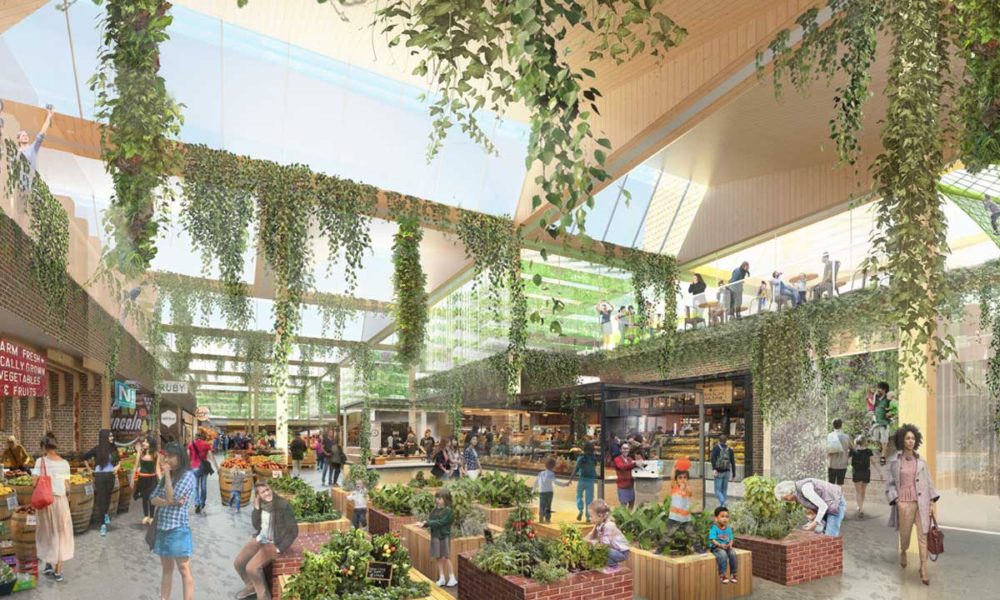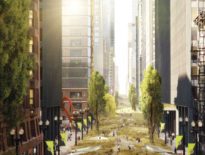“Imagine a building designed and constructed to function as elegantly and efficiently as a flower: a building informed by its bioregion’s characteristics, that generates all of its own energy with renewable resources, captures and treats all of its water, is toxic free and beautiful.” From the Living Building Challenge Standard
In March of this year, the Living Future Institute of Australia (LFIA) asked designers around the world to consider this fundamental aspiration of the Living Building Challenge—in the context of a retail center in suburban Melbourne, Australia. The Brickworks Living Building Challenge design competition asked built environment professionals and students to compete for more than AUD $30,000 in prize money by designing a retail center for an old brickworks site.
Living Retail?
The New Yorker recently published an article entitled “Are Malls Over?” (March 2014) that professed to express what all workplace cubicle dwellers know—people like natural light and fresh air and, when deprived of them, feel oppressed. Perhaps for this reason, more than two dozen malls have closed in the US since 2010.
The WorldGBC report Health, Wellbeing and Productivity in Retail: The Impact of Green Buildings on People and Profit, solidifies this proposition with the inclusion of data from the International Council of Shopping Centres (ICSC), which showed that “lifestyle” centers—those connected by pathways and are largely outdoors instead of contained within undercover malls—perform better. The survey tells us what we all intuitively know: that better buildings are visited more frequently and enjoy a higher number of repeat visits.
So instead of a “fast-as-possible” or “tolerated” experience, shopping centers must become genuine destinations that offer an increasing array of services for the local community. Traditionally a sector grounded in excess and waste, the shopping center of the future is surely one that attracts more foot traffic, is a place to be enjoyed, functions beautifully, promotes positive health and well-being, and has a net positive impact on its environment. What better tool exists than the Living Building Challenge (LBC) to provide the framework needed to realize what the shopping center of the future could be?

A Unique Prospect
The design competition was introduced because when the LFIA originally set out to ask what the world’s most sustainable retail center looked like, no one really knew the answer. At its heart, we were asking designers to consider the LBC in a new sector, in a country that has yet to see a certified Living Building, and on a real site with real-world constraints, owned by a real developer, Frasers Property Australia.
Describing their aspiration to create the world’s most sustainable retail center, Peri Macdonald, Frasers property head of retail says, “[We are] not just about using tools or securing ratings. We continuously invite design teams, professionals, students and anyone else interested to not just think outside the square, but reinvent the box. We are calling on extraordinary people to think boldly.”

Passionate people would spend huge amounts of time and energy to both unearth and give birth to new ideas in this new context: ideas that could be potentially applied to retail centers worldwide. As such, one of the key moves in the design competition was that the intellectual property for these ideas stayed with the designers—a unique gesture that many designers greatly appreciated.
Out-Of-the-Box Ideas to Celebrate
The winning prize in the Design Student Category, called “Burwood Life Centre,” by University of Melbourne students Bhargav Sridhar and Monica Sutisna, integrated an orchard, with rammed earth as an amazing visual feature that also uses excavated materials on site. This was a design that included a research lab and library, and the addition of bees to the site for pollination and regeneration.

The professional commendation went to a project titled “The Gathering,” led by KPA Architects. The design was based around a central garden that connects two levels of a building that behaves like a flower, with inwardly embracing elements that stretch outwards. When asked what the main challenges for retail center design were in pursuing the Living Building Challenge, the design team noted that:
“A challenge we faced was to grapple with the seemingly conflicting outcomes of the retail center. On the one hand a retail center encourages consumerism, needing to be profitable by bringing in more foot traffic or through more spending. On the other hand is the social benefit to the shoppers and community, being a place of physical and psychological health and well-being which implies an austere simplicity.”

The professional runner-up prize and winner of the People’s Choice Award went to a project titled “For the Common Good—A Restart to Retailing,” which was a collaboration between Buchan Group, Grün Consulting, and Inhabit. Their design displayed an inventive digital communication and education concept, where the center became a community gathering space instead of a shopping center, challenging traditional thinking whereby the design “starts with sustainability” and works backwards to make retail fit (which is the opposite of common practice to treat sustainability as an add on).

The Professional Winner was an outstanding submission called “The Difference is Living,” by thirty passionate professionals from eight organizations: dwp|suters, Aurecon, CJ Arms, reedbed technology, Eco Harvest, Biomimicry Australia, Future Food, and Watpac. Using a modular “screwed not glued” construction typology that could be taken apart and reused later in the retail center’s lifetime, and integrating key principles of biomimicry, the team created a social heart at the project’s center, invoking strong spirit of place and acting as a link between the retail and residential communities.
When asked about their experience of the design competition, the team responded:
“The Living Building Challenge is the Everest of sustainability challenges, to reach LBC’s demanding targets we found that everyone in our team needed to walk in the shoes of others. As architects we had to understand what the builders require; our engineers needed to see things from the shopper’s perspective and so on. Intense cross-discipline collaboration, open mindedness and engagement were key to developing breakthrough ideas that actually work in practice.
Ultimately sustainability in itself is not a discipline or skillset that can be added onto projects. Understanding that sustainability is a way of thinking and living, as opposed to a service, is fundamental.”

A Legacy for the Future
Alongside the competition for professionals and design students, the LFIA held a similar competition for students attending local primary schools. The winning design came from a student at Antonio Park School and showed practical ways to reduce energy demand using solar panels, natural light and external shading, and water captured and distributed via cleverly placed funnels that filter it down through vertical gardens. The design also illustrated a human scale, with a focus on pedestrians and cyclists—noting that the main entrance was not a car park! The prize for the winning school, and a legacy for the competition itself, was a 5kW solar photovoltaic system, to be installed by one of Australia’s market leaders, Solgen Energy Group.
Wider Impacts
At the awards party in June, several other prizes reflected the competition’s impact beyond this one site. Two special commendations in particular were awarded for standout efforts that went well beyond the call of the design competition.
The first special commendation went to a project called “Living Retail,” by NH Architecture, Ark Resources, Aspect Studios, E2 Designlab, Ceres, and Mott MacDonald. The submission was a visually impressive “long life, loose fit” design, integrating high-density residential buildings, included a mobile batching plant to address waste, and proposed an arrangement whereby the retail tenants pays for power, incentivizing battery storage. Aside from the innovation presented in the project, the remarkable thing about this piece of work, and hence the award, is that some of the team that produced it have been working on the site with Frasers Property. Being ineligible for a cash prize, this team went to great lengths to re-examine their own design work, and reimagine it in the context of the LBC, outside of the design competition itself.
The second special commendation was awarded for an entry called “The BioVale,” by DesignInc Melbourne, WSP | Parsons Brinckerhoff, Outlines Landscape Architects, and Will Nash. Within the course of the competition time frame, the team did some remarkable volunteering, contributing to a number of not-for-profit community and environmental groups, including tree planting with Landcare, a Trail Walker with Oxfam, and Bushcare at an Australian National Park. Their volunteering work stood out among more than twenty projects that received many hours of volunteer time as one of the design competition outcomes.

In addition to the remarkable volunteering, the design competition also required entrants to try out their skills in advocating for greater transparency through the Declare label, and improved social justice through the Just label. More than fifty organizations in Australia were contacted as part of the design competition, being asked to consider “nutrition labels” to provide a holistic picture of both the products they produce and the human story behind those products.
Summing Up
The overall response to the design competition has been overwhelmingly positive, and speaks to a compelling vision for a living future that we wish to share. Much like the LBC itself, the entire exercise has been unique in that it has not been about settling for previous notions of best practice; instead, it adopts an uncompromising and unashamed future focus to ask questions we may not yet have the answer to, but which we cannot afford to ignore.
The act of casting a global net to elicit truly innovative and progressive designs to unlock new possibilities for sustainability in retail, a traditionally wasteful sector in need of new ideas, has shown us that from primary school students and manufacturers to world-leading designers, inspiration can come from anywhere. This competition has unlocked some truly different thinking, and that’s what the Living Building Challenge is all about.



